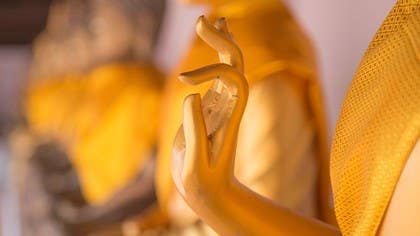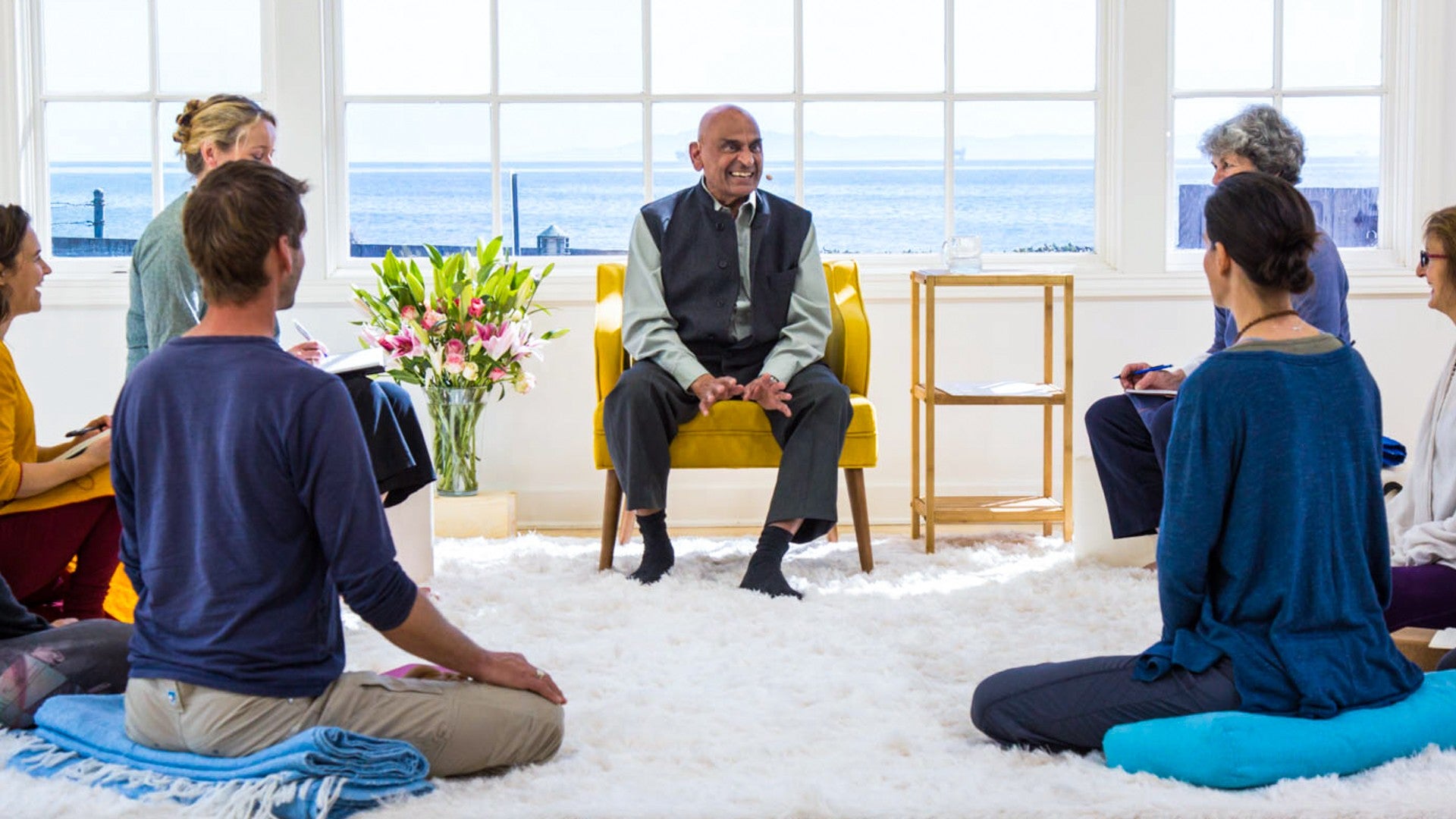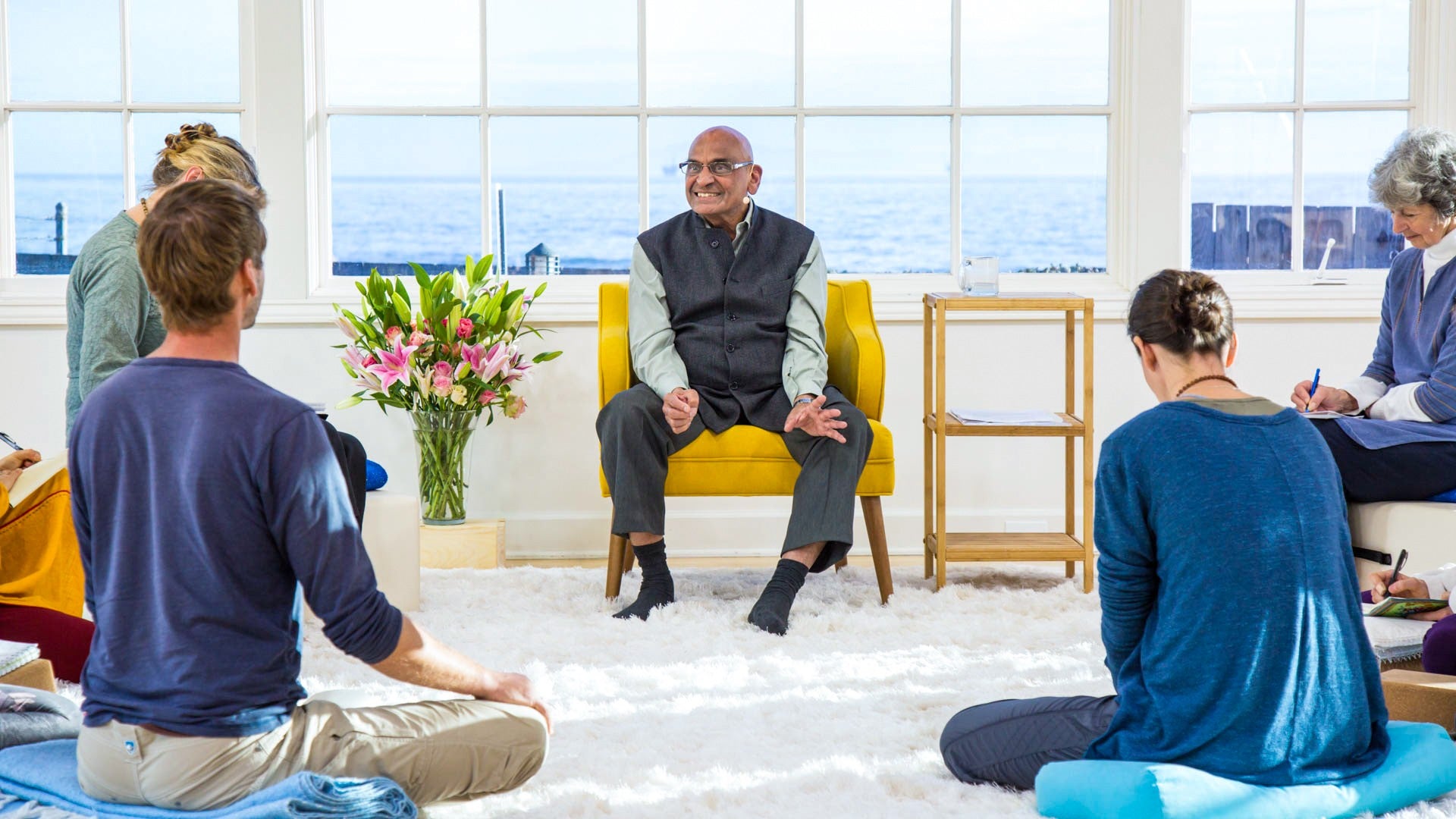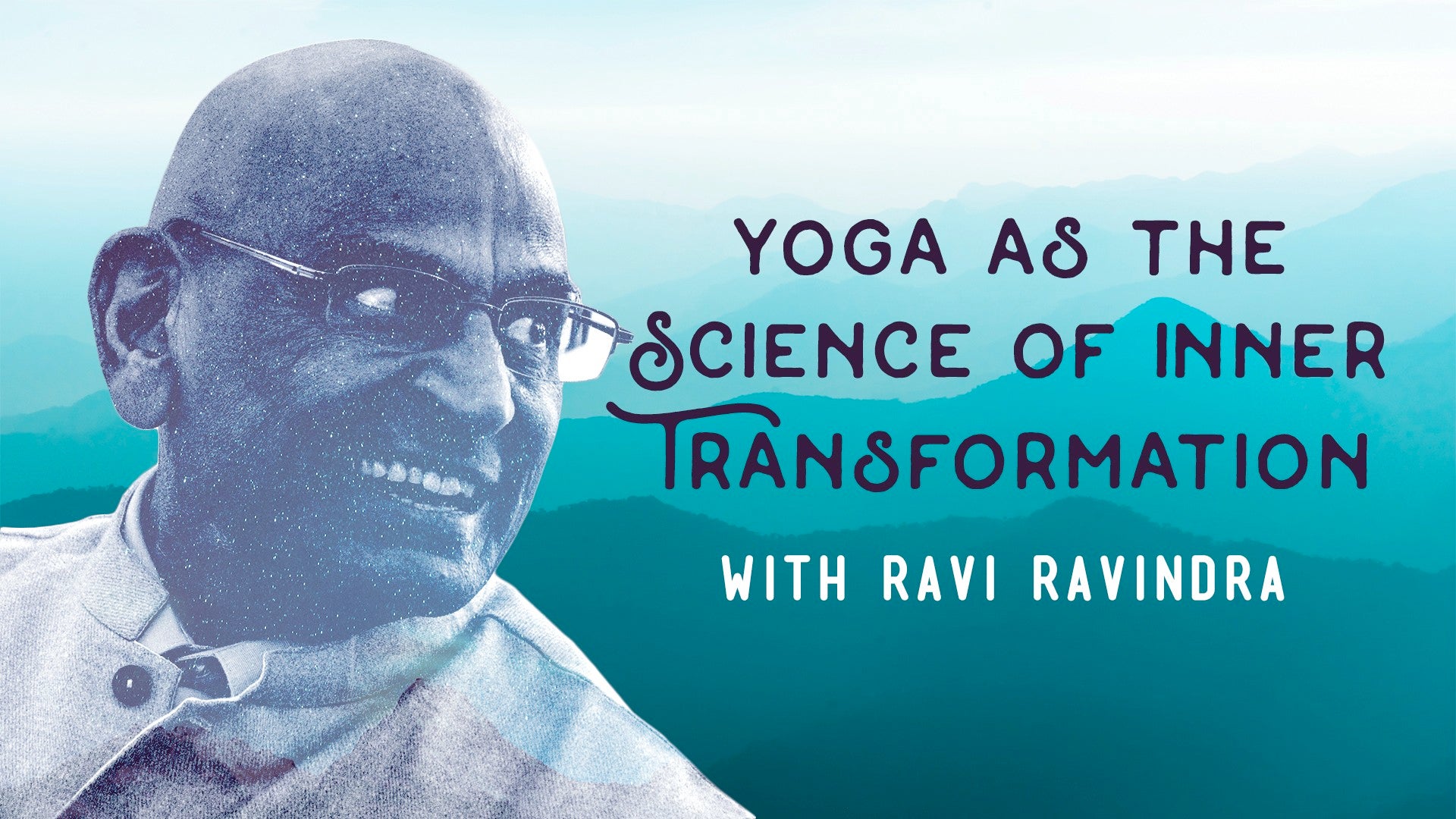
Perception in Yoga and Physics
In spite of our wish for a reconciliation between science and mysticism, we are very far from even having clear questions to raise in this context. We wish these disciplines to be reconciled because they both appear to us to be significant and profound manifestations of the human psyche. We imagine that somehow in modern times we have found a reconciliation. Of course, we tend not to be very clear as to whether we are thinking of the scientific revolution of 1905 when Einstein put forth his theories, or of quantum mechanics which was developed in the 1920s, or of holography of the 1960s, or of theoretical developments in the understanding of chaos or dissipative structures.
One can say without ambiguity that both yoga and physics, a form of scientific knowledge, are interested in objective knowledge. On the other hand, it is also true that the two 'knowledges' are different from each other. Many of the differences between them are related to the nature of perception in the two disciplines. The primary reason for pointing out some of these differences is to avoid settling for an easy integration or for a superficial reconciliation. Nothing is more soporific than to imagine there is peace when there is no peace. The illusion that we have already found what we need will prevent us from seeking further.
At every stage in the history of science, some people have thought, as some do today, that they have the right answers. Furthermore, they think that they know and are talking about precisely the same things as the great mystics or sages of the past have spoken about. For example, Newton regarded himself very much in the line of the priest scientists of Chaldea and the Brahmins of India and claimed his Law of Gravitation to be a restatement in mathematical form of what these ancient sages had said in other ways. But if the insights and the answers of the ancient sages do not appeal to us, then we say that now we have the right answers and that the earlier people had been mistaken. Every age somehow believes that the present scientific theories have really the correct answers or will soon have them. Still, we remain inwardly fragmented and in sorrow.
The sages of the Vedas and the Upanishads or the Biblical prophets have been saying what they have said for thousands of years, and we find much in common among them across the ages and across geographic distance. Our scientific pronouncements are likely to change in ten years or a hundred years or one thousand years. Almost certainly they will change in another three or four thousand years, which is the length of time over which the sages and the prophets have been saying the same things. So, one wonders about this easy equation of something which is very transient with something which we ourselves say has not changed and will not change because it is eternal and timeless. Six thousand years from now the sages of the Vedas and other mystical sages will still say the same things, whereas we can be certain that the physicists will say different things. Unless we imagine that in our steadily progressive science, we scientists are saying today the same things as the Buddha or Lao Tze–with the implication that in the next hundred years we will be able to say wiser things–then we must see what the differences are in what the scientists and the mystics say and seek.
It is obvious that observations and perceptions play a very great role in scientific knowledge. In fact, if anything, one might say that one of the great hallmarks of the scientific revolution of the sixteenth and seventeenth centuries is the insistence on the part of the natural philosophers that observations were relevant to come to truth and that one could not just sit down and think in order to come to truth. The same is, of course, true in yoga: the whole point of yoga is to come to clear and direct perceptions. Thus it is clear that consideration of perception is central in understanding physics or yoga.
Before proceeding further, it is useful to be clear about what is meant by yoga here. There is a story in the Chhandogya Upanishad which conveys the meaning of yoga. A famous sage had a very bright son called Shvetaketu. When the boy came of age, his father said to him, “Son, in our family we have been Brahmins not only in name but because we have been seekers of Brahman . We have been called Brahmins because we have been ardent seekers of the Vastness. You must go and seek knowledge of Brahman.”
So Shvetaketu leaves home to seek knowledge of Brahman and he studies, as is said, for twelve years. When he returns, having mastered all the sciences, he is very learned, very arrogant, and very self-assured. He comes and tells his father about his learning. His father listens to him and asks him questions and determines that indeed his son is very learned. Then the father says, “Shvetaketu, you are so learned and so wise and so arrogant but did you learn that teaching by which the unhearable becomes heard and by which the unseeable becomes seen?” One can guess the answer Shvetaketu gave; he had not been taught to hear the unhearable and he had not heard of such a teaching. If he had, he would not have been so arrogant. Then Shvetaketu asks his father, who has knowledge of an altogether another order of reality, for instruction.
For our purposes here, yoga is that teaching by which the unhearable becomes heard and the unseen becomes seen. This does not refer to a specific path, but to any spiritual path by which an internal integration takes place so that one is available to an altogether different, more subtle and more comprehensive order of reality. Literally, etymologically, the word yoga means integration; a yogi is one who is integrated.
Experiment and Experience:
Any path by which human beings can be made whole and integrated is a yoga. It is important for us to be clear about the distinction between whatever we have come to call religion and a spiritual path. These two can happily exist apart from each other and, in general, they do seem to exist apart from each other. It may even be the case, at least this is my own personal impression, that most of what we call religion is actually an obstruction for a spiritual path. But here I wish to speak only about the path or the way of yoga.
Perception is very important in both physics and yoga. Objective knowledge is sought through both and empirical verification is important in physics and in yoga. They are experimental or experiential and empirical. But let me again draw a distinction between the two words, experiment and experience. The modern natural sciences are thoroughly experimental in character, but they are in fact almost determinedly contra-experiential. However, these two words are often used as if they meant the same thing.
Experiment comes from the Latin word experimentum and experience comes from the Latin word experientia. They are both derived from experiens, the present participle of experiri, which is made up of two parts, ex and periri. The second word is connected with the same root from which the word peril comes in English. In this connection, ex means ‘thoroughly’. So, to try something thoroughly, to put oneself in peril, to risk one’s self, to undergo –these are the root meanings of the word experiens. Experiment is also derived from this word; but for nearly three hundred years the words experiment and experience have been used in very different contexts. Experiment is no longer used as a transitive verb; it is used only intransitively, unlike experience. For example, I can experience a flower but I cannot say I can experiment a flower. I have to say I can experiment on a flower or with a flower. One might think that this is just linguistic finesse and it doesn’t really matter, but what is important is to draw attention to the fact that the word experiment, with the underlying attitude involved, already sets things apart from the one who is involved. One experiments on something; for example, one can experiment on human beings, with LSD, on rats, on flowers, on whatever. What one experiences is something different. A scientist in his laboratory experiments with things and makes measurements based on those experiments; it is wholly erroneous to say that the scientist experiences those things.
Personal Equation:
No doubt, in the case of simpler observations, sometimes experimenting and experiencing come close to each other or they may coalesce. But this is so only when one thinks of really simple observations; it is not so for practically any observations now made in science, especially in physics. The question of the involvement of personal perceptions in science is rather a complicated question; I can go into only some parts here. It is significant to point out that as scientists we must try, as assiduously and carefully as we can, to avoid what we call the personal equation. This question has nothing to do with the whole business of whether quantum mechanics has reintroduced the observer into the picture; that is quite irrelevant here. What I am trying to say here is whether I am feeling angry or happy, whether I have a lover or I don’t, whether I am short or tall, whether I am a Buddhist or a Hindu or a Christian, all such considerations are irrelevant to and must be eliminated from experimental observations. To be sure, historians of science have often pointed out that it is not always easy to be free of these considerations. When one actually looks at some previous scientific work, one can sometimes see that because so and so was German, the thinking was along certain lines, and because someone was English, the thinking proceeded along different lines. There are national styles of doing science, and there are specific decades and centuries during which specific problems were considered more important in England than in France. A scientist’s cultural and personal conditioning naturally affects the style and the direction of the inquiry. Nevertheless, one must try to eliminate from science what we call the personal equation.
We should follow this a little further because it is an important matter. Often it is said that this effort to eliminate the personal is what makes science international. Or, it is claimed that science is inter-subjective because individual scientists are not influenced by their subjective emotions. Underlying this is a wish for objectivity, and also a very correct perception that most of our ordinary emotional life is contradictory. It is based on ‘I like this’ or ‘I don’t like that’; or on fear or pleasure. It is a good idea for the sake of objectivity not to fall for these subjective ramblings of the heart or mind. There is a right perception underneath all of this, and the attempt in science has been, more particularly since the great scientific revolution of the sixteenth and seventeenth centuries, to be freed of these personal wishes and concerns in the process of making scientific observations and forming hypotheses.
But science has thrown out the baby with the bath water. It is a unanimous understanding in all spiritual disciplines (and this is the way I am using the word yoga here, rather than merely a set of beliefs) that the feelings themselves are an avenue to knowledge and that they are the instruments for the highest form of knowledge. A cleansing or a deepening of these feelings is required so that one can come to objective knowledge through feeling. One of Goethe’s very perceptive remarks was that mysticism is a dialectic of feeling. By contrast, one could say that science is a dialectic of reason. Even observations and experiments in science are primarily generated by reason and are in the service of reason.
There is no doubt that there is an interplay between theory and observation, or if you like, between conceptions and perceptions in both yoga and physics. But they enter these disciplines differently. In physics, experimental data, observations and perceptions are all in the service of theory. They either test theories or generate larger or more comprehensive theories. What we ultimately end up calling scientific knowledge is an ensemble of theories. Whereas, completely by contrast, the theory in yoga or in any spiritual discipline is in the service of perception. It ultimately doesn’t matter very much what theory one has. The theory is a device or a trick to quiet the mind or to enlarge the mind. Of course, theory is required in yoga as well. Along every path one has to study a lot of metaphysical theory. However, if a spiritual discipline remains within that, or if it remains in the service of enhancing further theories, it is merely empty theological talk. Such speculative talk is persuasive enough for us to know that one can be easily caught up in it; all sorts of theology schools and philosophy departments are dedicated to this enterprise.
The usual religious person or an ordinary yogi or a common person who aspires to be a mystic is as far from the Christ or the Buddha as an ordinary scientist is from Newton or Einstein. We might as well keep our attention on great scientists or sages so that we can understand the deep differences among them by looking at the best practitioners of their respective crafts. So what is at issue here? I don’t think that ultimately the point about the Buddha or the Christ is that they have a metaphysics or a theory. But the point about Newton and Einstein is that they have a theory. Their importance is due to their theories. Perceptions and conceptions play roles in physics different from what they do in yoga.
Now I wish to look at the attempt to eliminate the person from the equation. The wish for objectivity is the underlying motivation for this. However, the elimination of oneself or one’s emotions from scientific observation has far-reaching consequences. Strictly speaking, the nature of the scientist should not affect the observations made. Let me give an example: the only thing that is relevant to physical optics is that which would be available even someone who is blind. We need to ponder over this. In physics, the theories or the experiments in optics should be available even to a blind person. The state or the nature of the scientist is irrelevant to the observations. For example, whether it is the Buddha looking at the path of electrons or whether it is an ordinary person looking at them, even though they may see different things, we must select only that part of their perceptions which is common to both of them. I think this is a way of impoverishing our perceptions. Since the level of consciousness or the state of being of the scientist is irrelevant to the observations, the net result is that all scientific observations in reverse are irrelevant to the level of consciousness of the scientist. Nothing in science would help raise anybody’s level of being, at least nothing in science as we know it now, as we practice it now. It is actually built right into the metaphysics of modern science that the state of being of the scientists is irrelevant to the science they produce. Whether one is good or bad, fearful, hateful or kind is beside the point in determining one’s qualities as a scientist. (We should keep in mind that a majority of all scientists and technologists in the world actually work for the military or for the war machine in one form or another.) The assumption that the level of a person’s consciousness or the nature of moral preparation is irrelevant to the quality of science which is done is built into the procedures of science. Now I am simply pointing to the obverse of this idea: whatever we know in science is impotent in changing our level of being.
A very old philosophical debate which necessitated this kind of limitation on oneself is involved in this. This debate about the distinction between primary and secondary qualities took on a particular importance in the sixteenth and seventeenth centuries in Europe. In gathering knowledge, one cannot take everything into account; certain limitations must be imposed. The question about which qualities or which properties of matter are to be considered fundamental to reality and which are relatively speaking superficial arises. Or, in what basic terms should we attempt to explain the whole of nature? During the sixteenth and seventeenth centuries, very definite decisions were made about this, sometimes self-consciously, sometimes not so self-consciously. Those properties which could be mathematically and quantitatively determined such as mass, size, and proportion were considered primary. Later on, charge was also added to this list. But aspects of colour, taste smell and touch were not considered primary; they were regarded as subjective qualities, identified as secondary. Physicists can talk at length about their methods; although there may be uncertainties, within those limits there are procedures and ways to determine what the mass of an electron is. But if we were to ask what the colour of an electron is, it sounds a little ludicrous, although some physicists do have fun with that kind of thing. Then if we ask what the taste of an electron is, that is too subjective, because mass and charge constitute primary reality even though neither can be sensed directly by anybody for they are very abstract concepts. If one asks what the purpose of an electron is, one is out of the scientific arena altogether.
There are only certain properties of matter which are considered fundamental. Aspects like colour can be explained in terms of other entities which are ultimately related with mass and charge, for example, they may be explained in terms of vibrations of matter, or vibrations of an electric field. Obviously, some lucky guesses were made in the sixteenth and seventeenth centuries; so much of physics has been based on these with such remarkable success. It is worth while pointing out that this distinction between primary and secondary qualities which made colour essentially subjective and not a fundamental constituent of reality used to bother Goethe very much; this was an important point in his profound (but completely ignored) critique of Newton.
Perceptions in Yoga and Science:
Both science and yoga proceed from the assumption that reality as revealed by our ordinary senses is not quite what it in truth is; it is not the real reality. Both claim that the truth behind appearances cannot be seen with unaided or unrefined perception. A physicist tries to enhance the sensitivity of the organs of perception through the development of scientific instruments. This enhancement of the organs of perceptions is largely quantitative. I look at an object with the eyes I have; then with a microscope I can see smaller objects, or with a telescope, far-away objects, but I still look at them in exactly the same way; my valuation of them does not change. On the other hand, the direction in yoga is much as it is expressed by the great visionary William Blake who spoke of the need to cleanse one’s organs of perception. Such a cleansing is qualitative; the perception of the same reality before and after cleansing has a different quality and significance. Every spiritual discipline subjects the student to a great deal of personal suffering, because in a spiritual discipline the sculptor, the chisel, and the stone are the same –they are all parts of the self. One is trying to sculpt something out of the given stone and with means which are really in oneself, although teachers can help.
In a spiritual discipline, a cleansing of the internal organs of perception is required. Whenever one becomes aware of the muddiness of one’s perceptions, something like the Dark Night of the Soul ensues, causing much suffering to the person experiencing it. The elimination of feelings because they are unreliable is not suggested, but rather with the recognition that uneducated feelings are unreliable, one sees the need to undertake a discipline of training of the feelings so that one can come to reliable and more objective feelings.
In physics we externalize our perceptions, even of those things which are inside us. A computer can perform many of the functions of the ordinary organs of perception. For example, in an actual scientific experiment, it may be possible for us, given enough research grants, to set up a mechanism so that the scientists can go home to lunch and the data will be there when they come back. In many scientific experiments, the actual presence or participation of human scientists is not necessary for the collection of data. Of course, scientists are necessary to set up the experiment, to interpret the data, and to apply the results; so scientists are still needed. However, the actual scientific perceptions, precisely where there is a direct contact with reality, whether one is measuring the scattering of electrons, studying the heartbeat of a fetus in the uterus, or investigating the reactions of rats towards certain kinds of controlled stimuli, do not need real, alive human beings. Perceiving can be done without the presence of the scientists as far as the collection of data is concerned. That is to say, perceptions can be completely externalized and one’s organs of perception can be taken outside and quantitatively extended. This is not the case in yoga where, if anything, a complete and total internalization takes place. In both cases, however, it is asserted that our ordinary organs of perception, as they are, are not quite adequate for perceiving reality.
In yoga, there is a recognition of the fact, or an assumption if you like, that as one is so one sees. This is not at all true in science, because only those perceptions must be admitted, or are allowed to be admitted, for which it is irrelevant what kind of a person one is. A great sundering or separation between knowing and being is at issue here; the level of being of a person, or the state of consciousness of a person, is regarded as irrelevant for the sort of knowledge which is produced. It is important to ask: What is the point or what is the purpose of the knowledge involved in these two cases? Why are we so excited about scientific knowledge? Supposing we knew all about Mars, what would that change? Albert Camus remarked, in his Myth of Sisyphus, that whether the moon goes around the earth or the earth goes around the moon is quite irrelevant in life. As a young physicist, I was much bothered by this and wondered about this strange kind of philosophy. But why are we so interested in scientific knowledge?
Knowing and Being:
It is hard to answer this question readily. If one sees the uses to which scientific knowledge is actually put, in general, there seems to be a very strong wish for control and manipulation of whatever one studies. Of course, one recognizes that there are many things one studies which may not be subject to control, as least, not easily. They may be too far; as most things in astronomy are. Still the methods and procedures that have been developed are based on the wish for control. This was classically expressed by Francis Bacon, the patron saint of the Royal Society of London, that human beings should study nature in order to control her and utilize her for the betterment of the estate of humanity.
Now, this is hardly the point of view taken in yoga except for a recent emphasis in the last fifteen to twenty years in some scientific circles interested in the study of consciousness. However, whenever we approach the study of consciousness with our present scientific attitude, we are always going to ask how we can control it and how we can use it. When this attitude comes into psychology, particularly in the area of the transition zone between the psyche and the spirit, it always represents what classically used to be called demonic tendencies. If we proceed with the present scientific attitude to a study of the spirit, what we are going to be concerned with, even if we don’t actually formulate it as such, is how we can appropriate the spirit for our purposes and for our use. So we ask, how can we use meditation to get ahead in business, to be better lovers, or to be more successful? The attitude of a yogi would be not how I can appropriate the Spirit for my use but how I could be appropriated by the Spirit for its use. In yoga there is a fundamentally different attitude to the purpose of knowledge, and to the value of knowledge from what it is in science. Different kinds of perceptions and the means of perception are connected with these different approaches.
We might now take another step. One could say that in yoga the point of knowledge really is the ending of knowledge. This is how the word vedanta is translated literally, it means ‘the end of knowledge’. When one comes to the understanding or the realization of the essential unknowability of this Vastness (Brahman) of which one is a part, then one can become quiet in mind and heart and can come to participate in this Vastness. In that sense, one who knows Brahman becomes Brahman . One cannot know it, as it were, apart from it. What one is saying here is that the central problem is of being, not of knowing. In yoga, knowledge or knowing is in the service of being, and ultimately it is like a self-destructive art. If it serves a certain function, then that knowledge is transcended. Using a classical metaphor, knowledge is like a ladder one uses to go up; once one is up, it is stupid to be carrying the ladder. Science has a fundamentally different underlying metaphysics and part of that metaphysics assumes that being is not at all relevant to knowledge, and certainly there is no sense to going beyond knowledge.
In the sense that ultimately the point of yoga is to end knowledge, one could say that the aim of a yogi is also to end the clinging to the separateness or isolation of the observer or the perceiver. As is said, it is only when one can leave one’s self behind that one can follow Christ (John 12:25). The little self is made up of all this knowing: of the past, present, and future; of fears and pleasures; of likes and dislikes. When one speaks of the path of yoga as chiseling a stone to help something else emerge, as a sculptor helps the sculpture to emerge; it is precisely the chiseling away of the unnecessary parts that one has in mind.
Through yoga, right order emerges, as does the end of knowledge, the end of isolated individuality, the end of separation, and the end of time. According to Patanjali, the celebrated author of the famous Yoga Sutra, the greatest illusion is asmita. It is difficult to render this into English, but it is something like I-am-this-ness, a state of egotism. He went on to define this (and one can recognize a very similar remark made by William Blake) as the misperception that the seeing is limited by the organs of sight. Thus, the point of yoga really is to go beneath, behind, beyond, these ordinary organs of perception. As the Upanishads say, one who does not see that what is inside is also outside is verily deluded. Since to assume that the seer is constrained by the apparatus of seeing is a fundamental error, a yogi purifies and integrates the perceptions so that what is seen is not as much seen with the eyes as through the eyes.
Let me end the discussion of this particular point by quoting a part of a dialogue from a famous mystic, Jacob Boehme.
Disciple:Oh, how may I arrive at the unity of will, and how to come into the unity of vision?
Master: Mark now what I say; the Right Eye looks in you into eternity. The Left Eye looks backward in you into time. If now you suffer yourself to be always looking into nature, and the things of time, it will be impossible for you ever to arrive at the unity you wish for. Remember this; and be on your guard. Give not your mind leave to enter in, nor to fill itself with, that which is without you; neither look backward upon yourself. Let not your Left Eye deceive you, by making continually one representation after another, and stirring up thereby an earnest longing in the self-propriety; but let your Right Eye command back this Left.... And only bringing the Eye of Time into Eye of Eternity... and descending through the Light of God into the Light of Nature... will you arrive at the Unity of Vision or Uniformity of Will.
These days esoteric knowledge, from within this culture as well as from other cultures far away in space and time, is readily available in any bookstore. This knowledge is easily and promiscuously accessible. This is partly because of our scientific mentality which gives no importance to the distinctions between levels of being or between levels of knowledge. In such circumstances, where are our guardians? What are our safeguards? There is a traditional notion, not only in India but in every classical tradition of which I am aware, that truth is something for which one has to be prepared in order to understand it. But not only that; one has to be prepared to withstand it as well, because truth can be devastating. How are we preparing ourselves for a profound esoteric knowledge so that we can not only understand it but also withstand it? What preparation do our intellectual or political leaders have so that they won’t misuse this knowledge? How is this esoteric knowledge going to transform our being if we regard it just as we regard scientific knowledge?
To imagine that the science of today is equivalent to ancient esoteric knowledge, presumably because of some superficial similarities in some expressions, is an indication of a complete ignorance of the methods and aims of ancient spiritual traditions. Implicit in these sentimental assertions of similarity and equivalence of modern science and esoteric knowledge is a naive and arrogant assumption that tomorrow, or in the next decade or the next century, or surely by the next millennium our science will far surpass the knowledge of the ancient mystics, sages, and prophets. From a spiritual and traditional point of view, such assertions are not merely innocently ignorant, but dangerous and soporific; they are ways of nullifying the possibility of esoteric knowledge for bringing human beings into a state of wakefulness, to their proper place in the cosmos, to their responsibility in the maintenance of right inner and outer order, and to their real possibilities.
It is easy for us, individually and culturally, to be lulled back to sleep, away from a disquieting moment of waking up and seeing, into a dream in which we plan the conquest of inner space and of consciousness and in which we imagine ourselves at the same level of understanding as the greatest of past sages while remaining content with superficial appearances. By our refusal to be woken up by esoteric knowledge, and by our wish to master it for our own egoistic purposes, we prevent this knowledge from working in us to transform our being, to bring us to the end of that knowledge which is concerned with acquisition and control, to help us be free of ourselves and to bring us to a stillness in which we can be aware of our essential unknowing and not be paralyzed into inaction nor frightened into the lap of the deceptive security of explanations. Above all, we need right discrimination in order to see our situation clearly, and enough strength to bear the demands of transformation.
Let me end with a story which is relevant to this. There was a great sage in India called Bhagiratha. He made great efforts and undertook spiritual austerities; thus he was blessed with a boon by higher forces. Because he had seen human beings parched for the life-giving waters of real knowledge, he asked the gods to let the river Ganga that flowed in heaven descend to the earth. The boon was granted; but it was feared that since the river Ganga, which we might take here as esoteric knowledge, is used to flowing only in heaven, if it were to descend to the earth, the planet, or ourselves as an ordinary body-mind, not being prepared to receive the shock of Gang’s descent, would be shattered. Shiva, the lord of the yogis, agreed to take the impact of the descent of the river on his head. From there, it came down to the earth in seven life-giving streams. Of all the gods, Shiva is the guardian deity of transformation. He alone is able to overcome the sleep of illusion and subdue the force of desire with the fire of discriminative vision of his third eye. Who among us will invoke Shiva and act on his behalf in the present moment of deep crisis and radical opportunity?
Perception in Yoga and Physics was excerpted with permission from Science and the Sacred by Ravi Ravindra, Quest Books, Wheaton Il, 2002
Comments
No comments yet. Be the first!
















You need to be a subscriber to post a comment.
Please Log In or Create an Account to start your free trial.